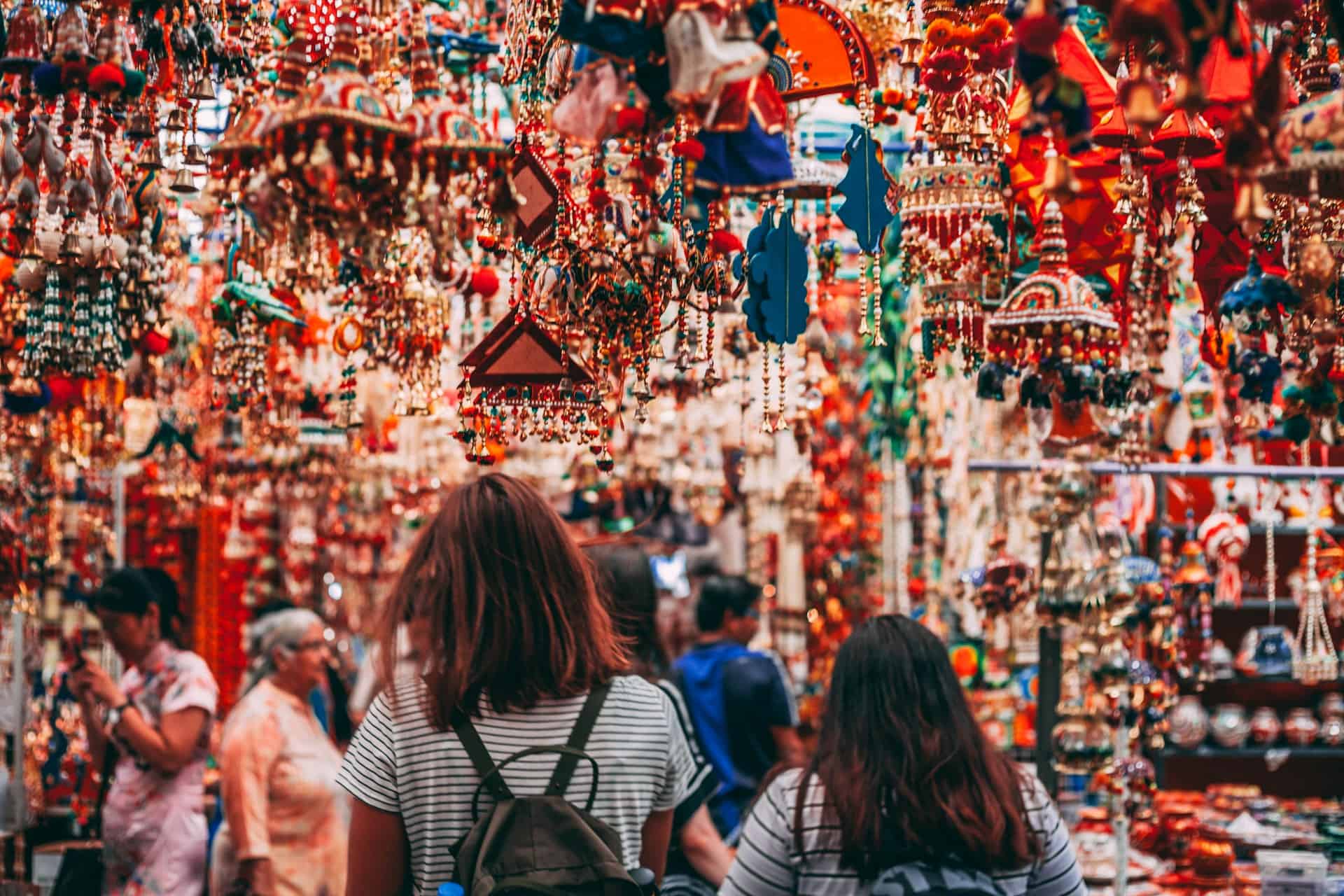Explore 9 of the oldest Indian markets where heritage, culture, and traditional crafts still thrive today.

Step into the chaos, colour, and charm of India’s oldest markets, where every corner tells a story and every sale is steeped in history.
They are style-soaked, culture-packed spaces that have seen everything from royal caravans to Instagram reels. Think ancient alleys bursting with silk, spices, silver, and secrets places where tradition meets hustle, and centuries of commerce still pulse with life.
Ready to wander through time and treasure? Here are seven iconic Indian markets that have been setting the vibe long before it was a trend.
Chandni Chowk, Delhi
Established in 1650 during the height of the Mughal Empire, Chandni Chowk stands as one of the oldest Indian markets and most iconic commercial hubs. Its creation was the vision of Jahanara Begum, daughter of Emperor Shah Jahan and Empress Mumtaz Mahal. Jahanara Begum envisioned Chandni Chowk as a bustling centre of trade woven seamlessly with cultural richness and aesthetic grandeur. The market’s name, meaning “moonlit square,” draws inspiration from a canal that once flowed through the centre of its main street.
Over the centuries, Chandni Chowk grew into a sprawling labyrinth of narrow lanes and bustling bazaars, each specialising in different trades and crafts. Today, it is still famed for its wide array of traditional Indian textiles, including exquisite sarees, chikan embroidery, and zari work; gold and silver jewellery from the historic Dariba Kalan area, wedding attire and accessories from Kinari Bazaar, and an eclectic mix of books, electronics, home décor, and perfumes. Food lovers recognise Chandni Chowk for its legendary street foods, such as Kebabs, sweets like Sahi Tukda and delicious parathas served in places like Paranthe Wali Gali.
Must-Buys:
- Classic silver and meenakari jewellery
- Authentic Indian perfumes
- Embroidered wedding apparel and lehengas
- Sahi Tukda, parathas (Paranthe Wali Gali), and traditional Delhi street food
How to Reach:
- Metro: Chandni Chowk (Yellow Line)/ Lal Quila (Violet Line), short walk to the market. Jama Masjid ( Violet Line) is also close by.
- Road: Easily accessible by auto, taxi, or cycle rickshaw
- Nearby: Red Fort, Jama Masjid, Sis Ganj Gurudwara, Jain Mandirs, Fatehpuri Masjid, and Paranthe Wali Gali.
Johari Bazaar, Jaipur
Johari Bazaar, situated in the walled Pink City of Jaipur, holds a glorious history that dates back over 300 years. The bazaar’s origins are closely intertwined with the founding of Jaipur itself by Maharaja Sawai Jai Singh II in the early 18th century. As the visionary ruler of the Kachwaha Rajput dynasty, Sawai Jai Singh II undertook the ambitious task of designing and establishing a fortified city that would serve as his new capital, blending strategic urban planning with artistic and cultural grandeur.
The bazaar, whose name “Johari” means jeweller, was deliberately carved out as the city’s premier jewellery market and quickly flourished under royal patronage. During Sawai Jai Singh II’s reign, which was marked by great interest in art, science, and architecture, Johari Bazaar attracted skilled craftsmen, gem traders, and artisans from all over Rajasthan and beyond. It became renowned not only for its exquisite collection of precious and semi-precious gemstone jewellery but also for highly specialised traditional forms such as kundan, meenakari (enamel work), and polki (uncut diamond) settings.
This market was a hub of cultural and commercial exchange, where the heritage of Rajput craftsmanship was showcased on a grand scale. Johari Bazaar mirrored the opulence and refinement of the royal court, with its glittering shops reflecting the wealth of Jaipur’s rulers and the city’s status as a centre of luxury and trade. Alongside jewellery, colourful textiles like leheriya and bandhani sarees, famous for their tie-dye techniques, flourished here, catering to the tastes of the nobility and merchants alike.
Must-Buys:
- Traditional Rajasthani “Thewa” and Meenakari jewellery
- Gemstone-encrusted bangles and anklets
- Lac jewellery, dazzling bridal sets
How to Reach:
- By Road: In central Jaipur, accessible via city autos, taxis, or rickshaws
- Closest Metro: Chandpole or Badi Chopad
- Nearby: Hawa Mahal, City Palace, Jantar Mantar, Tripolia Bazaar
Meena Bazaar, Delhi/Agra
Meena Bazaar traces its origins back to the 17th-century Mughal era and was originally established as a royal market exclusively for the women of the emperor’s household and noble ladies. This special bazaar, located close to monumental structures such as the Red Fort in Delhi and Agra Fort in Agra, served as a private shopping space where queens, princesses, and noblewomen could browse and purchase luxurious goods away from the public eye. Its name, “Meena,” literally meaning “woman,” reflects its exclusive nature and purpose of the bazaar.
Historically, the bazaar was known as Kuhs Ruz, or “Day of Joy,” an elaborate event or fair that spanned several days during which only women, with the exception of the emperor and select princes, could attend. The bazaar was a vibrant space where the royal women and ladies of the court set up stalls to sell high-end textiles, intricate embroidery, jewellery, and handicrafts. Often, the bazaar functioned as a charitable event, with proceeds raised being used for philanthropic causes. It was not only a place for commerce but also a social gathering where the ladies of the zenana (female quarters) could interact, exchange news, and display their exquisite taste and wealth.
Today, Meena Bazaar continues as a symbol of Mughal grandeur and feminine refinement, with present-day markets in both Delhi and Agra reflecting this rich heritage. Visitors can find a wide range of ethnic wear such as anarkalis, shararas, and intricately embroidered bridal lehengas, along with embroidered fabrics and jewellery. The bazaar also features Pakistani suits, dupattas, leather goods, perfumes, and curated souvenirs that echo the luxury once reserved for royalty.
Must-Buys:
- Heavily embellished wedding attire
- Handcrafted jewelry
- Agra-specific: marble inlay crafts
How to Reach:
- Delhi: Walk from Chandni Chowk or Jama Masjid; Metro – Chawri Bazar
- Agra: Near Agra Fort, rickshaws/taxis
- Nearby: Red Fort (Delhi), Jama Masjid, Agra Fort, Jama Masjid Agra
Ima Keithel (Mother’s Market), Imphal
Ima Keithel, meaning “Mother’s Market” in Manipuri, is a historic institution in the heart of Imphal, Manipur. This market dates back over 400 years and is celebrated as the world’s only all-women’s market. Uniquely, every stall is owned and operated exclusively by women, with men forbidden by custom from setting up shop here.
The roots of Ima Keithel reach deep into Manipuri history, where the role of women in commerce and social organisation has always been powerful. The market stands as a vibrant testament to the matriarchal traditions of Manipur, where generations of women, known as Imas or “mothers”, have sustained families, local economies, and the province’s cultural legacy through their stewardship of trade.
The resilience and resourcefulness of Manipuri women are woven into Ima Keithel’s very fabric. The market has not only survived the tides of time, including colonial rule, political upheavals, and social transformation, but has grown in size, diversity, and stature. Today, it remains a beacon of women’s empowerment, recognised nationally and internationally as a living example of women-led economic independence and communal solidarity.
Must-Buys:
- Bamboo and cane crafts
- Handmade textiles and jewellery
- Healthy Manipuri black rice
How to Reach:
- In central Imphal, a rickshaw/taxi from the airport/bus stand
- Nearby: Kangla Fort, Shri Govindajee Temple, Manipur State Museum
Laad Bazaar, Hyderabad
The name “Laad” refers to lacquer, a key material traditionally used in crafting the dazzling bangles for which the bazaar is famed. There are several intriguing legends about the bazaar’s origins. One popular story suggests it was established by the sixth Nizam’s wife, Ladli Begum, giving the bazaar her name. Another attributes it to Abdur Razzaq Laary, a general of the Golconda army, or even to colonial influences, where “Lord Bazaar” morphed into “Laad Bazaar.” Regardless of its precise beginnings, Laad Bazaar has remained a living heritage site that embodies Hyderabad’s rich artisan traditions.
Emerging during the Qutb Shahi period and thriving under the Nizams, the bazaar became synonymous with Hyderabadi bridal culture. It developed into a glittering hub where brides-to-be could find lac bangles studded with artificial diamonds, pearl jewellery, traditional Khara dupattas, rich embroidered sarees, and exquisite wedding trousseau items. The proximity to the majestic Charminar and historic Chowmahalla Palace enhanced the bazaar’s status as a cultural and commercial focal point.
Must-Buys:
- Hyderabadi pearl sets
- Lacquered bangles
- Zardozi embroidered sarees
- Traditional Khara dupattas, sarees, and embroidered fabric
How to Reach:
- Near Charminar, walkable from the Charminar Bus Stop
- Autos/rickshaws from anywhere in the Old City
- Nearby: Charminar, Chowmahalla Palace, Mecca Masjid
Sardar Market, Jodhpur
Sardar Market, situated near the iconic Ghanta Ghar (Clock Tower) in the centre of Jodhpur, is a bustling marketplace named after Maharaja Sardar Singh, who ruled Jodhpur from 1895 to 1911. The Clock Tower itself was constructed during his reign and stands as a prominent landmark symbolising the city’s modernisation and royal heritage. Built over 150 years ago, the market has since evolved into the commercial and cultural heartbeat of Jodhpur, reflecting the vibrant spirit, colour, and traditions unique to Rajasthan.
The market’s narrow lanes form a lively labyrinth lined with shops and stalls that have served locals and travellers alike for generations. Its historical significance is intertwined with Jodhpur’s royal past and the practical need for a trading hub that connected artisans, farmers, spice traders, and craftsmen to the wider regional economy.
Among its most prized offerings are aromatic spices like the famous Mathania red chillies and golden turmeric, essential to Rajasthani cuisine. The market is also a treasure trove for those seeking antique wares, handcrafted home décor, and intricate textiles. Shoppers can browse through stalls showcasing beautiful silver jewellery, artisan-crafted leather items, and finely embroidered mojris, traditional footwear that combines comfort with vibrant style. Every corner of Sardar Bazaar bursts with the craftsmanship and character of Rajasthan.
Must-Buys:
- Mathania red chilli powder
- Hand-block printed fabrics
- Jodhpuri juttis (shoes) and silverware
How to Reach:
- A walk or a short rickshaw ride from Jodhpur Junction
- By road/auto from anywhere in the old city
- Nearby: Mehrangarh Fort, Toorji Ka Jhalra stepwell, Jaswant Thada
Hogg Market (New Market), Kolkata
Hogg Market, officially known as Sir Stuart Hogg Market, was established in 1874 during the British colonial era. It represents one of the earliest examples of a planned municipal market in India and stands today as a living monument to Kolkata’s rich colonial heritage. The market was named after Sir Stuart Saunders Hogg, the then Chairman of the Calcutta Municipal Corporation, who was instrumental in its founding and urban development.
The market was designed by architect Richard Roskell Bayne, whose Gothic Revival style is evident in the red brick exterior, arched windows, and ornamental façade, lending the market an old-world charm that continues to captivate visitors. Constructed on Lindsay Street, the market replaced the old Fenwick’s Bazaar, providing a more organised and hygienic commercial space tailored primarily for the European settlers in Kolkata. The layout incorporated innovative engineering techniques for ventilation and cooling, making the market a comfortable shopping destination even in the sultry climate.
What you’ll find at the market is a lively mix of fashion, imports, and flavours. Garments and sarees dominate the stalls, with many shops also offering tailoring services for a perfect fit. Imported goods such as watches, perfumes, and electronics are widely available, catering to shoppers looking for both variety and value. And no visit is complete without sampling the vibrant street food and iconic Kolkata sweets that line the lanes, adding a delicious local touch to the shopping experience.
Must-Buys:
- Bengali sarees, imitation jewellery
- Sandesh and mishti doi (Bengali sweets)
- Imported perfumes
How to Reach:
- Walkable from Esplanade Metro, near Park Street
- Close to main city bus routes and trams
- Nearby: Indian Museum, St. Paul’s Cathedral, Park Street
Chor Bazaar, Mumbai
Chor Bazaar, located in Mumbai, is one of India’s oldest and most intriguing markets, with a history that spans over 150 years. The name “Chor Bazaar” literally translates to “Thieves’ Market,” a moniker that stems from its intriguing past. Originally, during the British colonial period, the market was called Shor Bazaar, meaning “Noisy Market,” because of the bustling crowds and lively haggling. Over time, British mispronunciation and local tales transformed the name to Chor Bazaar.
The market gained a reputation as the place where stolen goods and second-hand items were sold, a kind of black market for precious and everyday items. While that image persists in popular culture and films, today Chor Bazaar is better known as a sprawling flea market and treasure trove for collectors, vintage lovers, and antique enthusiasts. It has evolved into a legitimate trading hub, yet it retains a certain mystique rooted in its historic status as a bazaar alive with legends of hidden treasures and rare finds.
Must-Buys:
- Antique clocks and telephones, art deco curios
- Vintage memorabilia
How to Reach:
- Near Grant Road Station, a short taxi/rickshaw ride
- Nearby: Bhendi Bazaar, Mohammad Ali Road, Crawford Market
Attar Bazaar, Kanauj
Kannauj, often hailed as the “Perfume Capital of India,” has a remarkable legacy in the art of traditional perfume-making that stretches back over a thousand years. This historic city in Uttar Pradesh rose to prominence as a major centre of attar (natural perfume) production as early as the 7th century CE, long before modern perfumery methods took hold globally. The craft benefited from the city’s strategic location along ancient trade routes, allowing access to exotic flowers, herbs, spices, and essential oils from across India and beyond.
Throughout its vast history, Kannauj’s perfume industry flourished notably under powerful rulers such as the Guptas in ancient times and later the Mughals, who were passionate patrons of exquisite fragrances. Mughal emperors like Jahangir particularly favoured Kannauj’s rose attar, ordering large quantities for their courts, thus cementing the city’s reputation for fine perfumes.
Kannauj’s markets are renowned for their traditional attars made from rose, jasmine, sandalwood, musk, and rare varieties like Mitti attar and Heena. Shoppers will also find pure essential oils, handcrafted soaps, incense infused with natural fragrances, and cosmetic oils for skincare and wellness. It’s a fragrant journey into India’s perfume heritage.
Must-Buys:
- Pure “mitti attar” (earth perfume)
- Rose and kewra water
How to Reach
Kannauj Railway Station, taxis/rickshaws to the main bazaar
Read More: Latest



